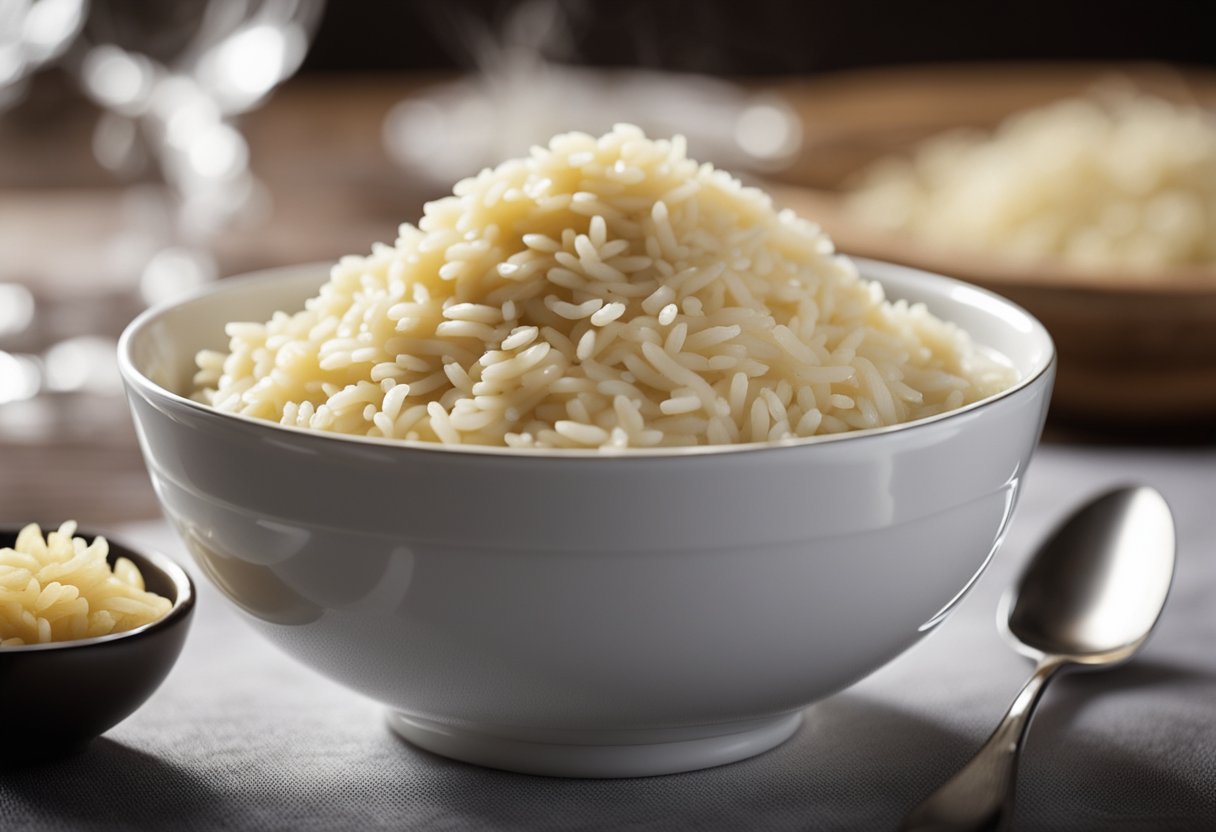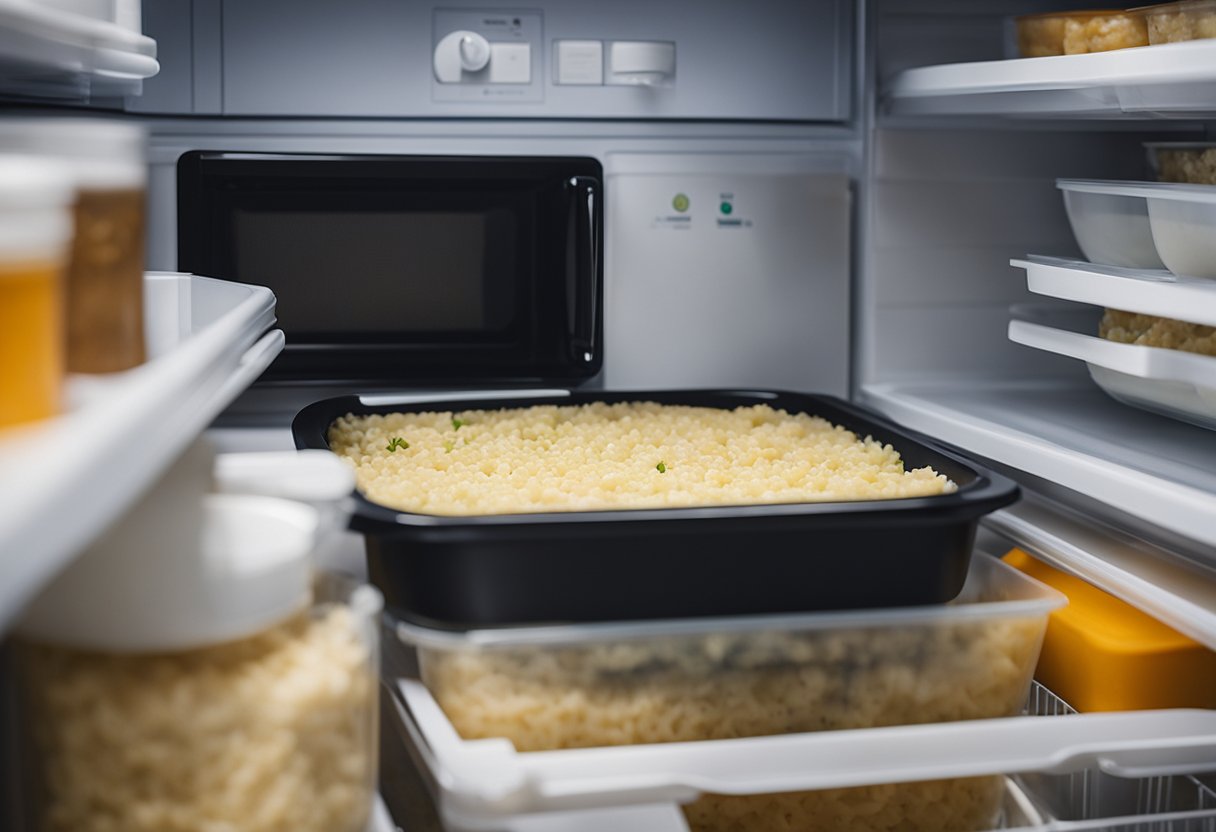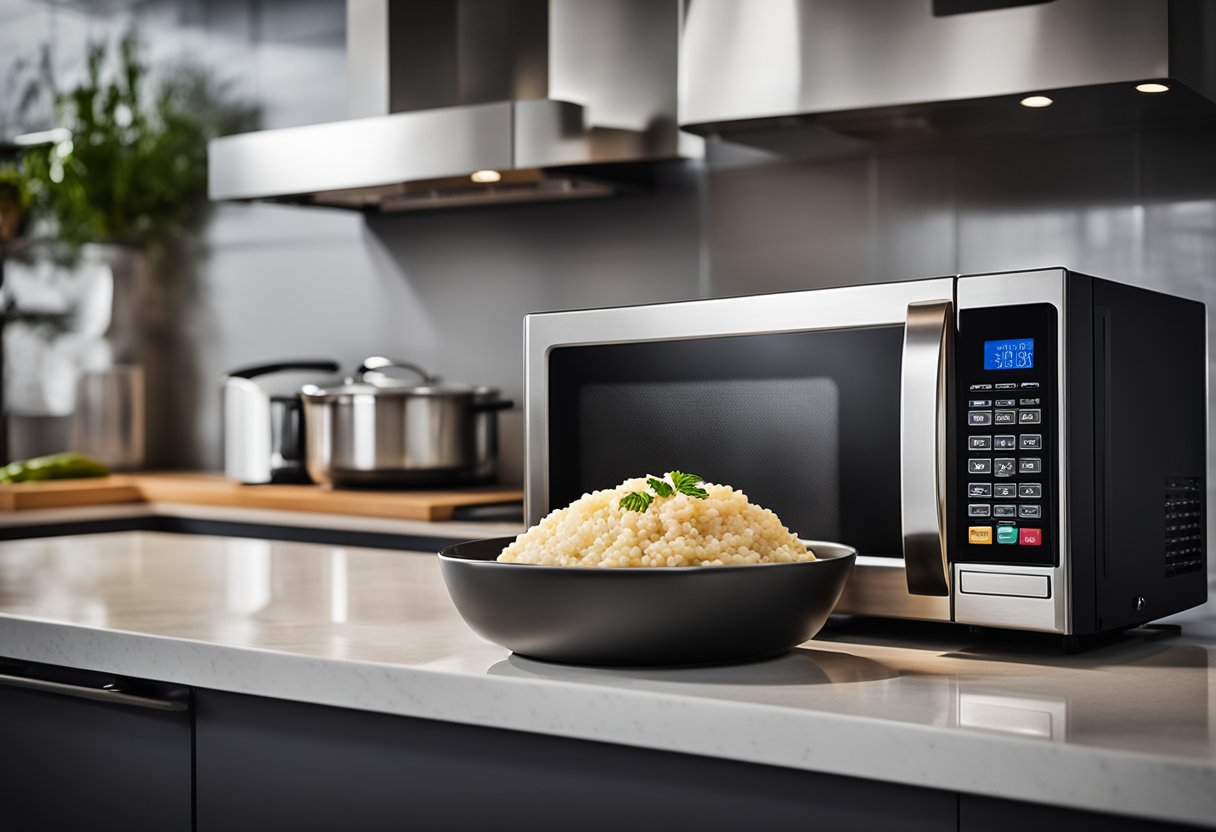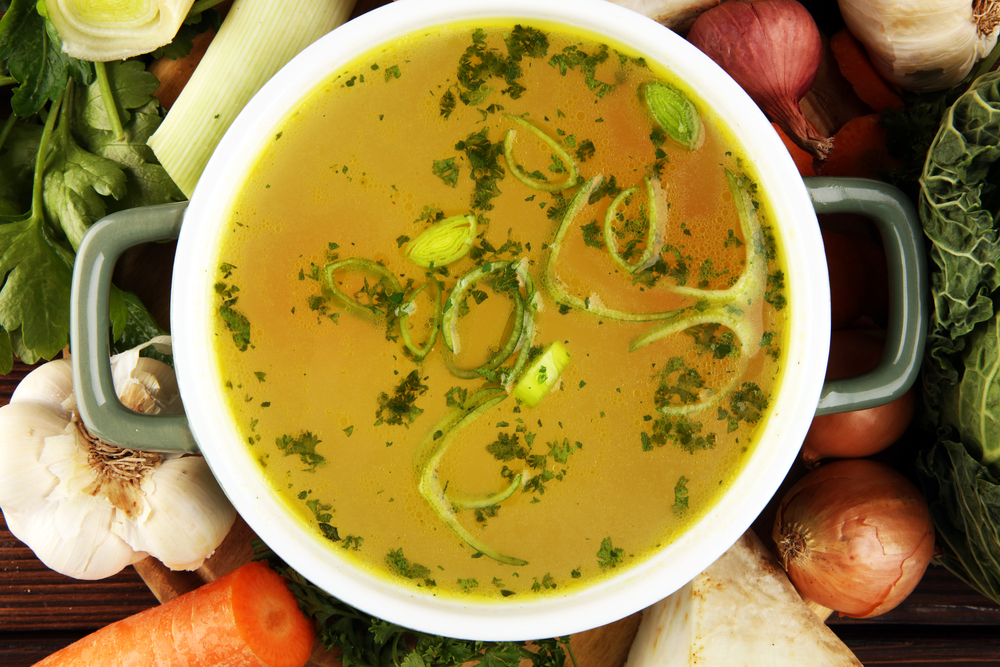Reheating risotto can be a challenge. If you don’t do it right, you can end up with a dry, clumpy mess.
But with the right technique, you can bring your leftover risotto back to life and enjoy it just as much as the first time around.

Understanding risotto is the first step to reheating it properly. Risotto is a creamy Italian rice dish that is made by slowly cooking arborio rice in broth until it becomes tender and creamy.
Because of its creamy texture, reheating risotto can be tricky. But don’t worry, there are several methods you can use to reheat your risotto and make it just as delicious as it was the first time around.
Storing leftover risotto properly is also important to ensure that it reheats well. You can store leftover risotto in the refrigerator for up to four days or in the freezer for up to two months.
When you’re ready to reheat your risotto, there are several methods you can use, including reheating on the stove, in the oven, in the microwave, or by steaming.
In this article, I will walk you through each of these methods and provide tips and tricks to help you reheat your risotto perfectly every time.
Key Takeaways
- Risotto is a creamy Italian rice dish that can be challenging to reheat.
- Properly storing leftover risotto is important to ensure that it reheats well.
- There are several methods you can use to reheat your risotto, including on the stove, in the oven, in the microwave, or by steaming.
Understanding Risotto

As a chef, I have come to appreciate the beauty and complexity of risotto. This Italian rice dish is a favorite for many people, and it’s not hard to see why.
Risotto is creamy, rich, and satisfying, with a unique texture that sets it apart from other rice dishes.
One of the keys to making great risotto is understanding the starch content of the rice. Arborio rice, which is the most commonly used rice for making risotto, is high in starch.
When the rice is cooked slowly and carefully, the starch is released, creating the creamy texture that is so beloved in this dish.
Another important factor to consider when making risotto is the texture. Risotto should be creamy and moist, but not soupy. It should have a slight bite to it, with each grain of rice retaining its shape and texture.
To achieve the perfect texture, it’s important to add the liquid to the rice slowly, stirring constantly to release the starch. This process takes time and patience, but it’s worth it in the end.
When it comes to reheating risotto, it’s important to be gentle with it. Risotto can be delicate, and if it’s reheated too quickly or aggressively, it can become dry and overcooked.
There are several methods for reheating risotto, including on the stove, in the oven, or in the microwave. Each method has its own advantages and disadvantages, and the best method will depend on your specific situation.
As a chef, I recommend using a non-stick pan to reheat risotto on the stove. Adding a little butter, olive oil, and liquid (such as wine or broth) can help to restore the creamy texture of the dish.
It’s important to stir the risotto frequently to prevent it from sticking to the pan or becoming too dry.
Overall, understanding the unique characteristics of risotto is key to making and reheating this beloved dish. With a little patience and attention to detail, anyone can master the art of risotto and enjoy its rich, creamy goodness.
Storing Leftover Risotto

When it comes to storing leftover risotto, it’s important to do it properly to maintain its quality and freshness. Here are some tips on how to store leftover risotto:
- Refrigerate: Leftover risotto can be stored in the refrigerator for up to five days, depending on the ingredients used. Make sure to transfer it into an airtight container or cover it with plastic wrap before placing it in the fridge. This will prevent it from drying out and absorbing any odors from other foods in the fridge.
- Freeze: Unfortunately, risotto does not hold up well to being frozen. The texture can change quite drastically, causing your rice to get too hard and take on a grainy texture. If you must freeze your risotto, make sure to do it in small portions and use it within a month.
- Safe container: When storing risotto, make sure to use a safe container that is microwave and freezer-safe. Glass containers with locking lids or plastic containers with tight-fitting lids work well.
- Storing food: When storing leftover risotto or any food, it’s important to keep it at a safe temperature. The danger zone for food is between 40°F and 140°F, where bacteria can grow rapidly. Make sure to refrigerate or freeze your risotto within two hours of cooking it.
- Store risotto: To store risotto, let it cool down to room temperature before transferring it into an airtight container. You can also add a tablespoon of olive oil to the risotto to help keep it moist.
- Leftovers: If you have leftover risotto that you don’t plan on eating, consider using it in other recipes. You can use it to make arancini, stuffed peppers, or even a risotto frittata.
- Fridge: Make sure to keep your fridge clean and organized to prevent cross-contamination. Store your risotto on the top shelf of the fridge, away from any raw meats or vegetables.
By following these tips, you can store your leftover risotto properly and enjoy it later without compromising its quality and flavor.
Refrigerating and Freezing Risotto
When it comes to storing leftover risotto, refrigeration is the best option. Simply place it in an airtight container and store it in the refrigerator for up to five days.
The risotto will thicken due to the starch in the rice, but it can easily be revived with a bit of liquid when reheating.
If you want to keep your risotto for a longer period, freezing is the way to go. Freezing risotto is safe and easy, and it allows you to enjoy your favorite dish on a later date.
To freeze risotto, place it in an airtight container or a freezer-safe plastic bag. Make sure to remove as much air as possible to prevent freezer burn.
When you’re ready to eat your frozen risotto, simply thaw it in the refrigerator overnight. Once thawed, reheat it in a saucepan with a bit of liquid, such as broth or water.
Alternatively, you can reheat it in the microwave, but be sure to stir it frequently to prevent hot spots.
It’s important to note that while freezing risotto is safe, it can alter the texture and flavor of the dish.
The rice may become slightly mushy, and the flavors may not be as vibrant as they were when the risotto was freshly made. However, if you’re in a pinch and need to store your risotto for a longer period, freezing is a great option.
When it comes to storing risotto, it’s important to use a safe container. Avoid using containers that are not meant for the freezer, as they may crack or break when exposed to extreme temperatures.
Stick to freezer-safe containers or plastic bags to ensure that your risotto stays fresh and safe to eat.
Defrosting Frozen Risotto
When it comes to defrosting frozen risotto, there are a few methods you can use. The best method will depend on how much time you have and how quickly you need to defrost the risotto. Here are three methods you can try:
1. Defrost in the Refrigerator
One of the easiest ways to defrost frozen risotto is to simply transfer it from the freezer to the refrigerator. This method is also the safest, as it prevents the growth of harmful bacteria.
To defrost in the refrigerator, simply place the frozen risotto in a covered container and leave it in the fridge for several hours or overnight. Once the risotto is fully defrosted, you can reheat it using your preferred method.
2. Defrost at Room Temperature
If you’re in a hurry and need to defrost frozen risotto quickly, you can try defrosting it at room temperature. To do this, remove the frozen risotto from its packaging and place it on a plate or tray. Leave it at room temperature for a few hours, or until it is fully defrosted.
However, it’s important to note that this method can be risky, as it allows bacteria to grow more easily. Make sure you only use this method if you plan to reheat and eat the risotto immediately.
3. Defrost in the Microwave
If you’re really pressed for time, you can try defrosting frozen risotto in the microwave. To do this, place the frozen risotto in a microwave-safe dish and cover it with a damp paper towel.
Microwave on the defrost setting for a few minutes, or until the risotto is fully defrosted. However, be careful not to overheat the risotto, as this can cause it to become dry and rubbery.
No matter which method you choose, make sure to always reheat the risotto thoroughly before eating. And remember, if you’re not sure whether the risotto is safe to eat, it’s always better to err on the side of caution and throw it away.
Reheating Risotto on the Stove
When it comes to reheating risotto, using a stove is one of the best methods. Reheating risotto on the stove is a simple process that can be done in a few easy steps. Here’s how to do it:
- Place the risotto in a non-stick pan over medium heat. Make sure to use a pan that is large enough to hold the risotto without it overflowing.
- Add a small amount of liquid to the pan. You can use water, broth, or a combination of both. The liquid will help to rehydrate the risotto and prevent it from drying out.
- Stir the risotto constantly as it reheats. This will help to distribute the heat evenly and prevent the risotto from sticking to the bottom of the pan.
- Continue to stir the risotto until it is heated through. This should take about 5-10 minutes, depending on the amount of risotto you are reheating.
- Once the risotto is heated through, remove it from the heat and add a small amount of butter. This will help to add richness and flavor to the dish.
- Stir the butter into the risotto until it is melted and well combined.
By following these simple steps, you can easily reheat risotto on the stove and enjoy a delicious meal without having to start from scratch.
Just remember to keep the heat on low to prevent the risotto from burning or sticking to the pan, and to stir it constantly to ensure even heating.
Reheating Risotto in the Oven
When it comes to reheating risotto, the oven can be a great option. It’s easy and convenient, and it can help to preserve the texture and flavor of the dish. Here’s how to do it:
- Preheat your oven to 350°F (175°C).
- Place your risotto in a baking dish. Make sure it’s spread out evenly so that it heats up evenly.
- Cover the dish with aluminum foil. This will help to trap in moisture and prevent the risotto from drying out.
- Place the dish in the oven and bake for 15-20 minutes. The exact time will depend on the amount of risotto you’re reheating and the thickness of the dish.
- Remove the dish from the oven and check the risotto. If it’s not hot enough, you can put it back in the oven for a few more minutes.
- Once the risotto is hot all the way through, remove it from the oven and serve immediately.
When reheating risotto in the oven, it’s important to keep an eye on it to make sure it doesn’t dry out. If you find that your risotto is still a bit dry after reheating, you can add a bit of broth or water to it to help moisten it up.
Overall, reheating risotto in the oven can be a great option if you’re looking for a quick and easy way to enjoy your leftovers.
Just be sure to keep an eye on it to make sure it doesn’t dry out, and you’ll be enjoying a delicious meal in no time!
Reheating Risotto in the Microwave
When it comes to reheating risotto, the microwave is the quickest and easiest way to do it.
However, it’s essential to note that the rice will continue to cook and absorb liquid, so it’s best to stop reheating when it’s still a little undercooked. Here’s how I reheat risotto in the microwave:
- First, I take the risotto out of the fridge and let it sit at room temperature for a few minutes. This step is crucial because it allows the rice to warm up a bit, making it easier to reheat evenly.
- Next, I transfer the risotto to a microwave-safe container. It’s essential to use a container with a lid to prevent the rice from drying out.
- I add a tablespoon of water or broth to the container, depending on the flavor of the risotto. If the risotto is already quite moist, I skip this step.
- I cover the container with the lid and microwave it on high for 1-2 minutes, depending on the amount of risotto. I stop the microwave every 30 seconds to stir the risotto, ensuring even heating.
- Once the risotto is hot and steamy, I take it out of the microwave and stir it well. If the risotto is still a little undercooked, I let it sit for a minute or two to finish cooking.
It’s essential to note that reheating risotto in the microwave can cause it to lose some of its creaminess and texture.
To counteract this, I sometimes add a little butter or cream to the risotto after reheating to restore its creaminess.
Overall, reheating risotto in the microwave is a quick and easy way to enjoy leftover risotto. Just be sure to follow these steps to ensure even heating and preserve the flavor and texture of the dish.
Steaming Risotto
When it comes to reheating risotto, steaming it is one of the easiest and most effective methods. Steaming helps to retain the moisture in the risotto, so it doesn’t dry out or become clumpy.
To steam risotto, you will need a steamer basket. Fill a pot with a small amount of water, making sure that the water does not touch the bottom of the steamer basket. Bring the water to a boil over low heat.
Once the water is boiling, place the risotto in the steamer basket and cover it with a lid. Steam the risotto for 5-10 minutes, or until it is heated through. Be sure to stir the risotto occasionally to ensure that it heats evenly.
If you find that the risotto is still a bit dry after steaming, you can add a small amount of liquid, such as broth or water, to the dish.
This will help to bring back some of the creaminess that can be lost during the reheating process.
Overall, steaming is a great way to reheat risotto, as it is quick, easy, and helps to retain the dish’s original texture and flavor.
Transforming Leftover Risotto
When I have leftover risotto, I like to transform it into something new and exciting. Here are a few ways to do just that:
Arancini
Arancini are deep-fried rice balls that are a popular Italian snack. They are made by forming leftover risotto into balls, rolling them in breadcrumbs, and then deep-frying them until they are golden brown and crispy on the outside.
You can also add an egg to the risotto before forming it into balls to help it hold its shape. Once they are cooked, you can serve them with a dipping sauce of your choice.
Risotto Fritters
Risotto fritters are similar to arancini, but they are flattened into patties instead of being formed into balls. To make them, simply mix some flour, parmesan cheese, and an egg into your leftover risotto.
Then, form the mixture into patties and fry them in olive oil until they are crispy and golden brown.
Cheesy Risotto Balls
If you want to add even more cheese to your leftover risotto, you can make cheesy risotto balls. To do this, simply mix some shredded cheese (such as mozzarella or cheddar) into your leftover risotto.
Then, form the mixture into balls and bake them in the oven until the cheese is melted and bubbly.
Transforming leftover risotto is a great way to make the most out of your leftovers.
Whether you choose to make arancini, risotto fritters, or cheesy risotto balls, you can be sure that you will have a delicious and satisfying meal.
Additional Tips and Tricks

When it comes to reheating risotto, there are a few additional tips and tricks that can make the process even smoother and more successful. Here are some things to keep in mind:
- Use butter or fat to add flavor: If you find that your reheated risotto is lacking in flavor, try adding a small amount of butter or another type of fat to the pan. This can help to bring out the flavors of the other ingredients and make the dish taste richer and more satisfying.
- Add liquid gradually: When reheating risotto, it’s important to add liquid gradually to avoid making the dish too soupy or mushy. Start with a small amount of liquid and add more as needed, stirring constantly to ensure that the rice heats evenly and doesn’t stick to the bottom of the pot.
- Experiment with different types of stock: While low-sodium chicken or vegetable broth is a common choice for reheating risotto, you can also try using other types of stock, such as meat stock or mushroom stock, to add different flavors to the dish. Just be sure to adjust the seasoning accordingly to avoid making the dish too salty.
- Use a large pot: When reheating a large batch of risotto, it’s important to use a large pot to ensure that the rice heats evenly and doesn’t stick to the bottom of the pan. This can also help to prevent the rice from becoming too mushy or overcooked.
- Don’t overcook the rice: When reheating risotto, it’s important to avoid overcooking the rice, as this can cause it to become mushy and lose its al dente texture. Instead, aim to heat the rice just until it’s warmed through and the liquid has been absorbed.
- Try adding wine: If you have a bit of leftover wine on hand, you can try adding a splash to your reheated risotto for an extra burst of flavor. Just be sure to let the wine cook off before adding any additional liquid.
- Use boiling water to reheat white rice: If you’re reheating a dish made with white rice, such as a rice pilaf or fried rice, you can try using boiling water instead of stock to add moisture and prevent the rice from drying out.
- Add vegetables or corn to the mix: If you want to add some extra nutrients and flavor to your reheated risotto, try adding some chopped vegetables or corn to the mix. This can help to add texture and flavor to the dish, as well as make it more filling and satisfying.
Frequently Asked Questions
How long can you keep risotto in the fridge before reheating?
You can keep risotto in the fridge for up to 4 days before reheating. It is important to store the risotto in an airtight container to maintain its freshness.
If you are unsure about the quality of the risotto, it is better to err on the side of caution and discard it.
What is the best way to reheat risotto without a microwave?
The best way to reheat risotto without a microwave is on the stove. Heat 2-3 tablespoons of low-sodium stock or water for each cup of leftover risotto.
Once hot, reduce the heat to medium and add the risotto. Reheat the risotto for 4-5 minutes until it’s nice and creamy again. Stir frequently while reheating.
Is it safe to reheat risotto more than once?
It is not recommended to reheat risotto more than once. The more times you reheat the risotto, the more likely it is to dry out and lose its flavor and texture.
It is best to reheat only the amount you plan to eat and store the rest in the fridge or freezer.
Can you freeze leftover risotto?
Yes, you can freeze leftover risotto. Let the risotto cool to room temperature, then transfer it to an airtight container or freezer bag.
Label the container with the date and freeze for up to 3 months. To reheat, thaw the risotto in the fridge overnight, then reheat using your preferred method.
What are some creative ways to use leftover risotto?
Leftover risotto can be used to make arancini, which are deep-fried rice balls filled with cheese or meat. You can also use leftover risotto to make a creamy risotto soup by adding chicken or vegetable broth and some diced vegetables.
Another idea is to use leftover risotto as a stuffing for vegetables such as bell peppers or mushrooms.
How do you reheat mushroom risotto to maintain its flavor and texture?
To reheat mushroom risotto, use the stove method mentioned above. The key is to add a little bit of liquid to the risotto while reheating to maintain its creaminess.
You can also add some fresh mushrooms or herbs to the risotto while reheating to enhance its flavor.







